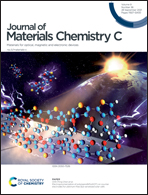Thermal enhancement of the 2H11/2 → 4I15/2 up-conversion luminescence of Er3+-doped K2Yb(PO4)(MoO4) phosphors
Abstract
Er3+ with different concentrations doped K2Yb(PO4)(MoO4) phosphors were prepared by a solid-state reaction method, and the layered orthorhombic crystal structure of the samples was confirmed by X-ray diffraction (XRD). Under the excitation of a 980 nm laser, the up-conversion luminescence (UCL) emission spectra of K2Yb1−x(PO4)(MoO4):xEr3+ (x = 0.05, 0.1, 0.5, 1, 2, 4, 6, and 14 mol%) phosphors were obtained, and moreover, the critical quenching concentration of Er3+ was found to be 1 mol%. Furthermore, the up-conversion (UC) optical temperature behaviors of the Er3+-doped K2Yb(PO4)(MoO4) phosphors were investigated. All phosphors showed a thermal enhancement of UCL corresponding to the 2H11/2 → 4I15/2 transition of Er3+ because of structural distortion, eliminating the energy transfer of Yb3+ to Er3+ through Er3+ single-doped isostructural K2Bi(PO4)(MoO4) with thermal enhancement UCL of the 2H11/2 → 4I15/2 transition. In addition, the variable temperature XRD results suggest that the K2Yb(PO4)(MoO4) host is a thermal expansion material, and the variable temperature confocal Raman spectra results confirm the thermal expansion and structure distortion of PO4 or MoO4 tetrahedra. With the increase in the sample temperature, the UCL emission intensity of the 2H11/2 → 4I15/2 transition of Er3+ ions at 663 K of K2Yb0.999(PO4)(MoO4):0.001Er3+ is up to 5.6 times that of 303 K. Through the fluorescence intensity ratio (FIR) technique, the corresponding maximum absolute sensitivity (SA) was derived to be 0.00866 K−1 at 550 K. The results indicate that the K2Yb(PO4)(MoO4) phosphors with a low Er3+ doping concentration can be applied at high temperatures as optical thermometers.



 Please wait while we load your content...
Please wait while we load your content...